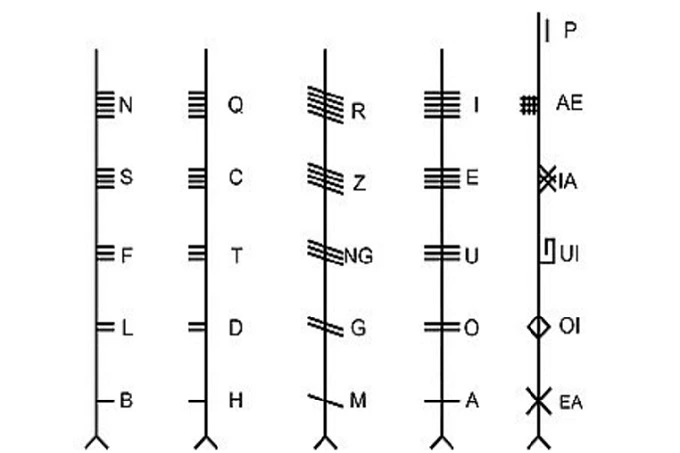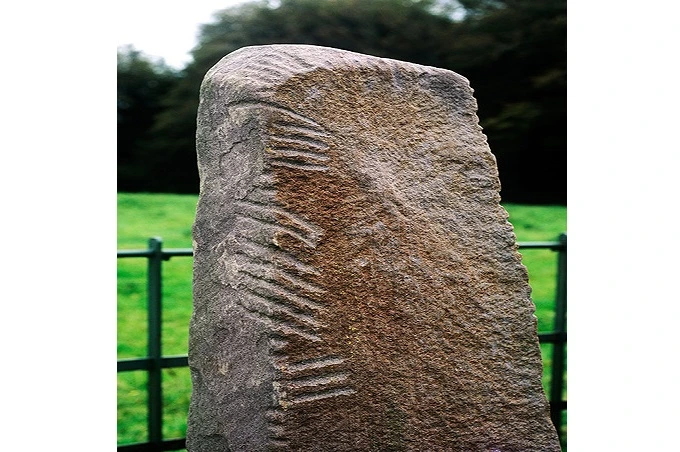What is the uniqueness of the Ogham alphabet?

The Celtic peoples employed the Ogham alphabet in ancient times, although the Latin alphabet eventually replaced it. However, ogham was used as a script in Ireland for a long time after it was banned. Today, it is solely used for divination purposes.
Following Celtic history, the Ogham alphabet was created by Ogma, son of the goddess Danu, who named it after his mother. He was physically powerful and agile, but he was also highly intelligent. Scholars have claimed that mythology began to develop following the invention of the written alphabet.
Professor Rhys suggests that the word “ogham” means “skillful use of words,” – and it is not without reason as the Ogamic alphabet was also employed as a cipher in ancient times. Whenever an alphabet was employed as a cipher letter, the letters in particular syllables were substituted by the names of the letters in the alphabet in question.
Some Celtic scholars also think that Ogham was a secret language used by the Druids, Celtic priests, to communicate with one another. This idea is based on the fact that the Druids used the fingers of their hands to communicate in a secretive manner throughout their time. They applied them on their nose or toe in different combinations, forming sentences that could only be understood by those who had been initiated.
Damien McManus thinks that the name of the writing derives from an Irish phrase that means “sharp cut,” since inscriptions on the stones were engraved using cutting tools, according to McManus.

A gravestone was also referred to as an “ogham” in ancient Ireland, and it is these types of ancient monuments have remained to the present day in Ireland.
The Ogham alphabet, according to some versions, was created by the Scythian ruler Fhenius Farsaid, who is often considered to have been the forefather of the Irish people.
When exactly the ogham arose is unknown. The surviving monuments, on which inscriptions are carved in the Ogham alphabet, date back to the 5th-6th centuries AD. The peoples of Ireland and Britain used the Ogham script. Some scientists believe that this writing arose much earlier.
The Ogham alphabet has letters made up of one to five strokes. The strokes are either oblique to the writing axis or directed straight against it. It seems as if they are linked together on an axis.
Although writing inscriptions are often carved on stones in the direction of left to right, downwards, the direction of writing on stones is more commonly from the bottom up.
No markers were separating the different words. Corners were used to indicate the beginning and conclusion of a text; in many ways, the marks for “more” and “less” in mathematics were used.
Another characteristic that separates the Ogham from other alphabets is the sequence in which the letters are written. The letters are grouped in four sets of five letters each.
At first, dots were used to signify consonantal sounds, and subsequently, dots were used again, but in a smaller size.

- The first group consisted of the letters b, l, n, f, and s.
- The second group consists of the letters h, d, t, c, and q.
- The third set of letters is m, g, z, and r.
- The fourth letter is composed of the letters a, o, u, e, and i.
Along with the basic 20 signs, there were extra signs for diphthongs: eo, oi, ui, io, and ae.
In the Oghamian language, the alphabet was referred to as the tree alphabet since each sign linked to a particular sound and a specific plant and god.
According to a particular method developed by the Druids, plants were classified together, and this system was later used in the formation of the Ogamic alphabet. The Welsh poetry “The Battle of the Trees,” written by an English poet, interprets the qualities of trees based on their personalities and features (mythological or real – unknown).
Druids in ancient times employed ogam signs to glimpse into the past and predict the future, as they do now. Even today, the Ogam is used for divination, along with other tools like cards and runes.
There are various methods of divination that may be performed using the Ogams, both simple and complex.
In contrast, if you opt to read the Celtic alphabet, you should create the signs using the most sophisticated technology available. You must carve 20 sticks as large as a finger out of various kinds of wood since each letter of the wood alphabet relates to a certain tree, as explained in the wood alphabet. Sticks with alphabetic letters cut out of them.

For this work, the following plants will be required: birch, ash, alder, willow, rowan, hawthorn, oak, holly, hazel, apple tree, grapes, ivy, reed, blackthorn, elderberry, pine, gorse, heather, aspen, yew.
The most simple way of reading fortune-telling is to choose one stick at random and infer its meaning from it. The information contained in the three sticks may be used to learn about the past, present, and future. There are a variety of other options.
Finally, here are some of the properties of trees that are worth mentioning:
- Birch – Cleansing, comfort, protection.
- Rowan – Victory over black magic and spirits.
- Alder – Confronting the enemy, a warlike sorceress.
- Willow – Sorcery, moon, water, sadness.
- Ash – Power, and strength. Militancy.
- Hawthorn – Protection, wealth, aggression.
- Oak – Courage, strength, protection from the enemy.
- Holly – Knight.
- Hazel – Justice, wisdom.
- Appletree – Perfection, beginning, and completion.
- Grapes – Enjoyment of life.
- Ivy – Rise in development, joy.
- Elderberry – Curse, connection with fairies and elves, witchcraft.
- Pine – Protection, purification, failure will pass by.
- Gorse – Prosperity.
- Heather – Tree of the world, power, travel.
- Aspen – Sighs and groans.
- Yew – Death, knowledge of the new, development.
However, the interpretation of the yew tree is intriguing – it represents both death and growth – and it is compatible with Celtic views about mortality. They believed in reincarnation and transmigration of souls, which means that each successive life is an opportunity for the soul to progress in its growth.




